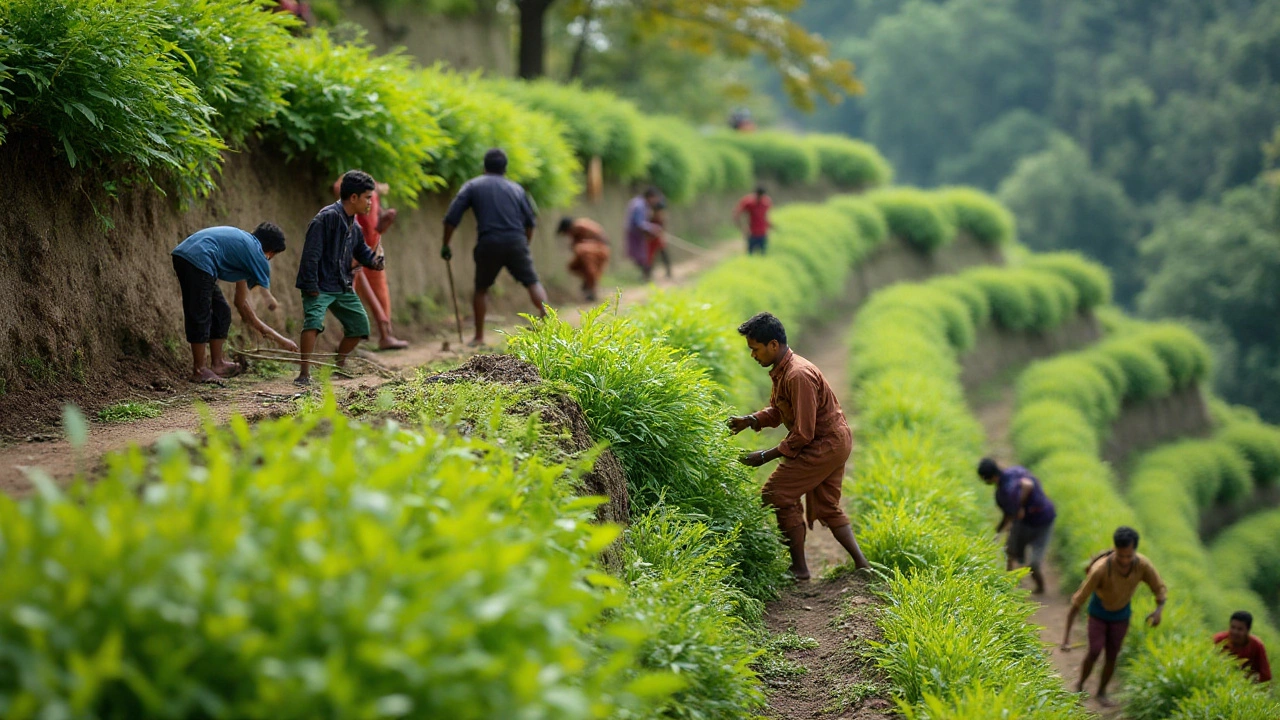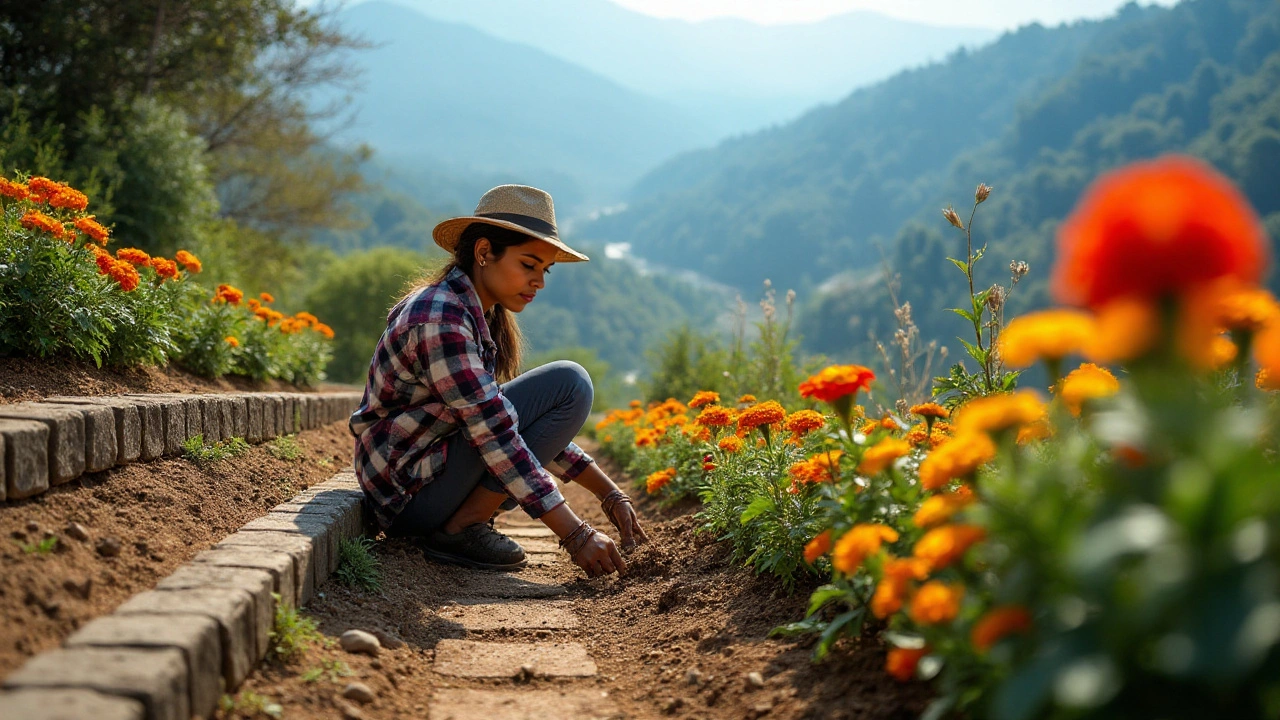Gardening on a slope offers unique challenges and tremendous rewards. While the natural inclination of sloped land can lead to soil runoff and erosion, implementing the right techniques transforms these areas into thriving gardens.
The first step towards a stable garden on a slope is understanding what causes soil instability. Recognizing the forces at play helps in tailoring strategies that both match and support the natural environment. From there, you can select suitable plants and construct barriers that blend aesthetic appeal with functionality.
Let us delve into these strategies, ensuring your sloped garden not only withstands the tests of time but flourishes with life.
- Understanding the Causes of Soil Erosion
- Choosing Suitable Plants for Slope Stability
- Implementing Physical Barriers and Retaining Walls
- Maintenance and Long-term Care for Sloped Gardens
Understanding the Causes of Soil Erosion
Soil erosion on sloped surfaces is a natural process, but one that can be accelerated by a variety of factors. The interplay between wind, water, and human activity often dictates the rate and extent of erosion. Water is perhaps the most formidable force; as rainwater moves down a slope, it picks up speed and force, carrying soil particles with it. This not only strips away the nutrient-rich topsoil but also creates grooves and rills that can deepen over time, exacerbating the problem. Wind, while less frequent, can be equally destructive, especially in regions with loose, sandy soils where lack of vegetation leaves the ground exposed.
Human-induced activities, like construction and agricultural practices, significantly contribute to increased erosion. The removal of vegetation, compaction of soil, and altering of natural watercourses can disturb the delicate balance of these ecosystems. A profound understanding of how these activities impact slope stability is crucial for gardeners and landowners alike.
"Erosion is a silent thief of soil fertility," notes Dr. Jane Smith, a respected soil scientist. "Understanding its causes is the first step towards effective mitigation."Such insights emphasize the importance of intervention and management techniques tailored to each unique landscape.
One cannot overlook the significance of soil composition in determining erosion susceptibility. Clay soils, for instance, hold water well but can become compacted and slippery, leading to mass movements under extreme conditions. Sandy soils, on the other hand, drain quickly but lack cohesion, making them prone to being blown or washed away. Understanding the specific characteristics of your soil permits you to adopt strategies suited to your terrain. Soil testing is a valuable tool in this regard, offering data that can inform decisions about planting and drainage solutions. A proactive approach, informed by scientific knowledge and tailored to the specific causes of soil erosion, sets the stage for sustainable slope management and thriving green spaces.

Choosing Suitable Plants for Slope Stability
When you consider planting on a slope, the choice of vegetation is crucial to slope gardening. The right plants act as natural anchors, their roots weaving through the soil like a supportive net, reducing the risk of soil erosion. It’s a symbiotic relationship where plants not only thrive but also protect the earth beneath. Compatibility with the local climate and soil condition tops the list of considerations, as it ensures the health and longevity of your garden.
Perennials are often recommended for such tasks due to their resilience and ability to establish deep root systems. Grasses like switchgrass and fescues are excellent choices, well-regarded for their extensive root networks. They can lock the soil in place, providing year-round coverage. Shrubs like creeping juniper and manzanita are adept at handling inclines gently, spreading across surfaces to keep the ground stable—all the while adding texture and color.
Switchgrass, a native to North American prairies, is particularly apt for sloped areas given its durability and deep-reaching roots. It requires minimal maintenance and boasts an impressive resistance to various environmental stresses such as drought and poor soil conditions.
"Grasses with fibrous root systems, such as blue grama and switchgrass, offer one of the most effective and natural ways to control erosion on slopes," notes Dr. John Bartolo, an expert in soil conservation at the University of Colorado.
Ornamental Grasses and Ground Covers
Incorporating ornamental grasses not only brings an aesthetic appeal but also adds functionality. Their clumping nature means better coverage and protection against runoffs. Furthermore, certain species such as blue fescue thrive in poor soil conditions while maintaining stability with their robust roots. Including groundcover plants like creeping thyme or vinca provides a lush carpet that inhibits erosion and suppresses weeds.
- Creeping Thyme: Not only does it cover the ground, but its fragrance is a bonus, creating a sensory experience in your garden.
- Vinca Minor: Offers both beauty and resilience, with shiny leaves and periwinkle blue flowers that not only charm the eyes but hold the soil firmly.
TREES: The Ultimate Stabilizers
Trees, though requiring more space and time to mature, provide unparalleled benefits for erosion control. Species like willow and oak are particularly effective due to their extensive root structures. These roots can expand several feet in depth and breadth, offering tremendous soil stabilization. However, understanding how to place them efficiently matters—planting at strategic intervals allows their root systems to intertwine for maximum effect.
| Species | Root Depth (in feet) | Ideal Soil |
|---|---|---|
| Willow | 6-15 | Moist, well-drained |
| Oak | 18 | Varied |
This choice of vegetation not only fosters a scenic garden but helps maintain its integrity, ensuring both beauty and functionality. As you embark on your journey to stabilize your slope with plants, remember that patience and careful planning can yield a flourishing and enduring garden landscape. Embark on this green path, and watch nature take its compelling course, anchoring soil while delighting the senses.

Implementing Physical Barriers and Retaining Walls
Stabilizing soil on a slope often calls for robust solutions, and retaining walls offer one of the most effective methods. By physically restraining the soil, these structures prevent erosion while enhancing the landscape's aesthetics. One does not require an engineering degree to understand the fundamentals involved. However, basic knowledge about the materials and techniques can go a long way. Retaining walls can be constructed using various materials like timber, stone, or concrete, each bringing its own set of benefits. Timber walls are often preferred for their rustic look, while stone and concrete offer durability and strength. It's important to decide on a material that not only matches the landscape design but also fits the budget.
Planning and designing the wall require attention to detail. The wall's height and length dictate its stability, with taller walls necessitating stronger foundations. Soil type and hillside gradient also play crucial roles in determining the complexity of the project. For those who prefer doing it themselves, starting with small-scale walls, such as under 4 feet in height, may be manageable. Higher and more complex structures generally require professional guidance to prevent unforeseen issues that could lead to extensive damage. Adopting a tiered approach not only enhances effectiveness but also adds visual interest to the terrain.
"Retaining walls must be installed with foresight," says renowned landscape architect Richard Connors. "A well-built wall can stand the test of time, provided it's designed to adapt to soil pressures and environmental changes."
Building physical barriers doesn't stop at retaining walls. The inclusion of other elements like terraces and steps can significantly enhance both accessibility and stability. Terraces help break the force of water runoff, reducing potential erosion risk. Steps carved into the slope make navigating easier, creating a cohesive and inviting garden space. Coupled with erosion control techniques, these structures contribute to an environmentally friendly garden that thrives with seasonal changes.
The preparatory steps are as crucial as the construction itself. Excavate the site properly and have a solid drainage plan to address water accumulation, which is one of the most common causes of wall failure. Effective drainage often involves a gravel foundation and perforated pipes that direct water away from the wall. Using geogrids or synthetic nets adds an extra layer of fortification, spreading the soil pressure more evenly and extending the lifespan of the wall.
Lastly, maintenance can't be overlooked. As seasons change, materials can shift, and unforeseen elements might contribute to structural wear. Regular inspections enable timely interventions, ensuring the slope gardening system remains intact. Cleaning drainage outlets and checking for cracks or buckling helps preempt any potential hazards. Implementing these measures, homeowners and landscape enthusiasts alike can create gardens that not only resist the whims of nature but do so with charm and elegance.

Maintenance and Long-term Care for Sloped Gardens
Maintaining a sloped garden requires ongoing attention, dedication, and understanding of how the landscape evolves over time. These gardens demand regular assessment, as shifts in soil, plant growth, and weather patterns all play significant roles in the long-term success of your green sanctuary. Monitoring these factors allows you to adapt and ensure that your efforts in slope gardening remain fruitful.
Rain can quickly alter the dynamics of a sloped garden, causing both soil erosion and waterlogging. Therefore, checking the integrity of your chosen drainage solutions with each seasonal change is crucial. It's essential to clear debris from existing drains and evaluate if additional systems are needed to cope with unexpected heavy downpours. This preventive approach not only preserves the stability of the garden but also enriches the health of your soil stabilization efforts.
Healthy plants contribute significantly to maintaining slope stability. Regular pruning encourages healthy growth, preventing plants from becoming too top-heavy and potentially uprooting from loose soil. Fertilization should match the needs of your garden's vegetation, creating a thriving ecosystem that can naturally counteract erosion. Implementing a mulching routine aids in moisture retention and provides a protective layer against erosion.
- Fertilize in late winter or early spring to prepare plants for the growing season.
- Keep pathways clear to ensure safe movement for both gardeners and wildlife.
- Install mulch or ground cover to reduce surface runoff.
- Regularly check retaining walls and other physical barriers for any signs of wear or damage.
Erosion control methods must evolve as your garden grows. This evolution might include planting deeper-rooted species, revisiting barrier configurations, or expanding vegetation to cover additional areas. It's a dynamic process akin to an orchestral piece in continuous composition. And as any gardener with a sloped vista will attest, enhancements are both visible in beauty and functionality.
"Gardening requires a lot of water – most of it in the form of perspiration." - Lou EricksonJust as garden care demands attention to detail, it encourages a hands-on appreciation of the work involved. Plan dedicated time to walk through your garden, observing from all angles to gauge plant health and slope stability. This practice not only keeps maintenance manageable but fosters an intimate connection with your crafted landscape. Your garden, like an enduring piece of art, evolves, breathing life into every corner of your sloped terrain.

